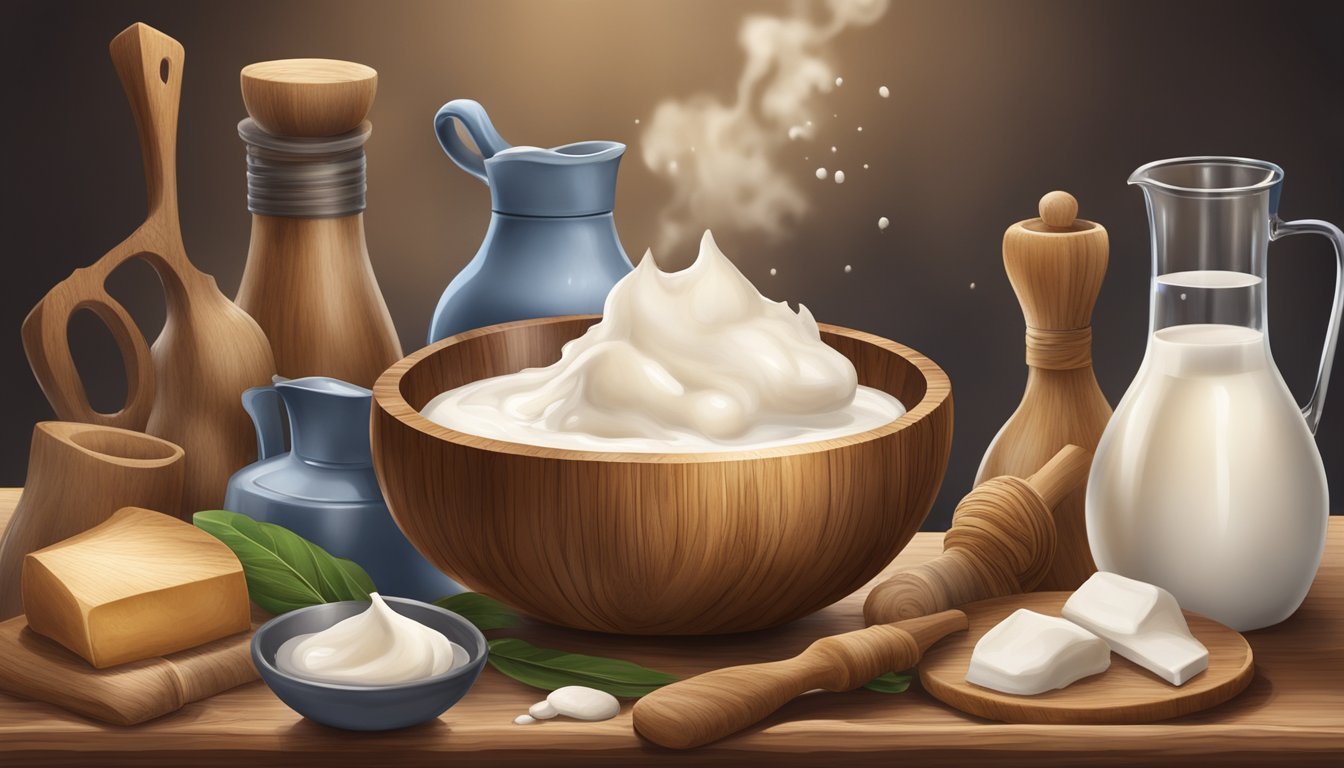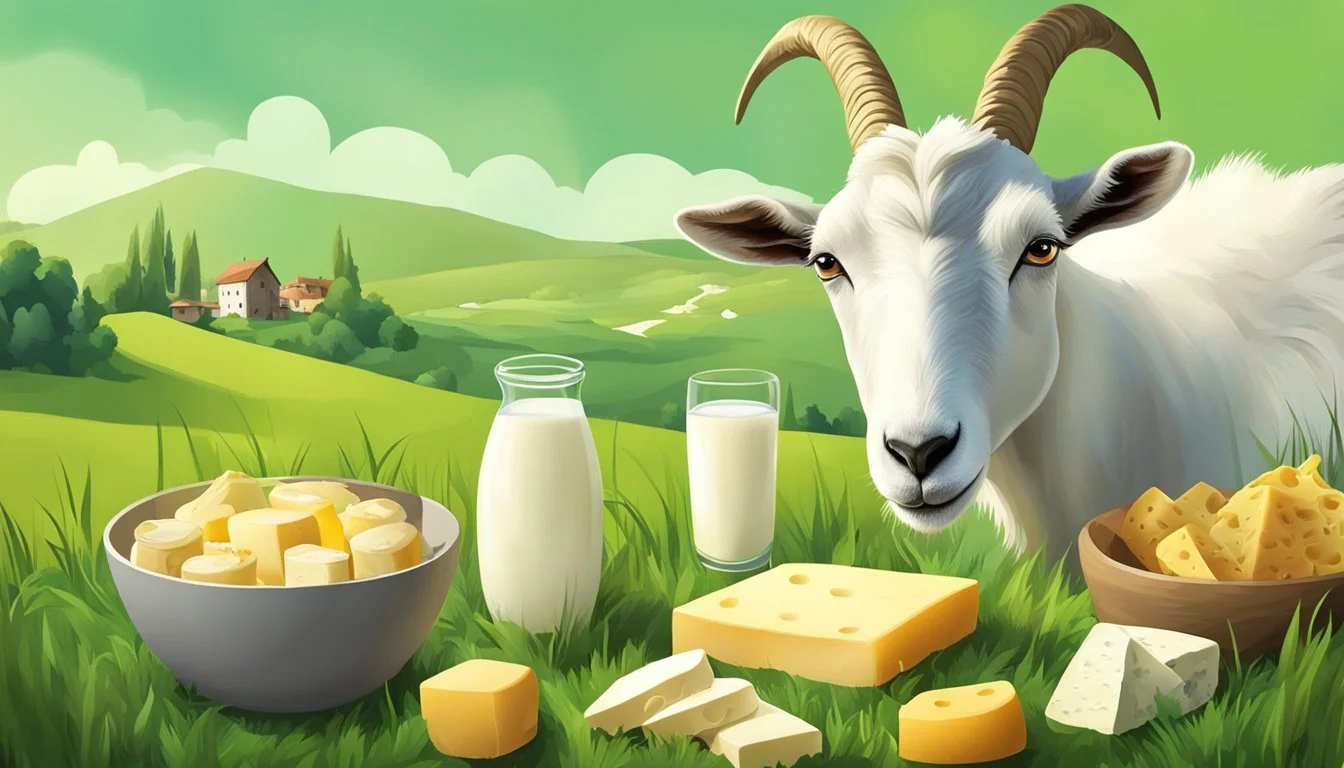The Role of Goat Milk
Bridging Traditional Diets and Modern Nutrition
Goat milk has long been a staple in many traditional diets and is now gaining popularity in modern cuisine for its unique nutritional profile and potential health benefits. The consumption of goat milk spans various cultures worldwide, where it is not only valued for its taste but also for the myriad of health advantages it presents. It is known for its digestibility and beneficial lipid metabolism, making it a preferred choice for individuals with lactose intolerance or those seeking alternative dairy options.
In recent times, the interest in goat milk has expanded beyond its traditional role, becoming increasingly recognized in the health and food industries. Research indicates that proteins found in goat milk may play a role in the prevention and treatment of certain diseases, marking it as a promising candidate in the development of functional foods and nutraceuticals. Its nutritional composition, which includes a rich content of essential minerals like calcium and phosphorus, alongside vitamins A and D, makes it an attractive option for a well-rounded diet.
As the demand for goat milk rises, its role in global nutrition continues to evolve, with its production and consumption experiencing growth across traditional and new markets. Whether consumed directly or through a variety of dairy products such as cheese and yogurt, goat milk's contribution to health and food sustainability remains significant, reflecting its versatile and enduring place in both ancestral and contemporary dietary practices.
Historical Significance of Goat Milk
Goat milk has served as a staple in human diets for thousands of years, a testament to its nutritional value and versatility. Its role predates many modern dairy practices, highlighting the enduring relationship between humans and goats.
Domestication and Early Use
The domestication of goats is believed to have occurred around 10,000 years ago in the Fertile Crescent, making them one of the first domesticated animals. Goat milk was one of the primary reasons for this domestication, as it provided a sustainable and nourishing food source for early agricultural communities. Inhabitants of these regions valued goats for their adaptability to harsh climates and terrains where other dairy animals could not thrive, thereby securing a vital role for goat milk in the subsistence of early civilizations.
Goat Milk in Traditional Diets Across Asia and Europe
In Asia, goat milk has been a cornerstone in the diets of pastoral nomads, such as those found in the mountainous regions of the Himalayas. Its importance in daily nutrition is also evident in various traditional Asian cuisines and medicinals. Conversely, in Europe, goat milk has historically been integral in Mediterranean diets. It has been used to make a variety of cheeses and fermented milk products cherished for their distinct taste and nutritional benefits. Throughout the Balkans and the Alpine regions, goat milk products have been a mainstay, reflecting the animals' suitability to the local environments and cultural preferences.
Goat Milk Composition
The composition of goat milk includes a complex array of nutrients, a distinctive physicochemical structure, balanced fatty acids, and an affluent profile of vitamins and minerals. Each component plays a significant role in deeming goat milk not only a nutritional substitute to cow's milk but also an ingredient with unique properties beneficial for a range of dietary needs.
Nutritional Profile
Nutritionally, goat milk is known for its high digestibility and lower allergenicity compared to cow's milk. It contains 13.2% total solids, among which there is approximately 4.5% fat, 3.6% protein, including both casein and whey proteins, and 4.3% lactose, which illustrates its rich nutritional content. Goat milk proteins possess functional properties, such as contributing to beneficial effects on the gut health and immune system, which makes it a suitable option for those with lactose intolerance or cow milk protein allergies.
Physicochemical Properties
Goat milk's physicochemical properties are differentiated by the size of its fat globules, which are smaller and more uniform compared to those found in cow's milk. This feature has implications for the digestibility and processing characteristics of the milk. The pH levels and milk composition can vary based on the lactating goat's health and metabolic disorders like ketosis or acidosis.
Vitamins and Minerals
Goat milk is particularly noted for its high levels of calcium, which is essential for bone health. It contains a balanced mix of vitamins such as A, D, B1, B2, and B3, which are critical for various body functions, including vision, skin health, energy metabolism, and maintaining proper nerve function. The mineral content such as phosphorus, potassium, and magnesium further enriches its nutritious value, supporting bodily functions from muscle contraction to blood pressure regulation.
Lipids and Fatty Acids
The lipid fraction of goat milk yields a rich source of various fatty acids, among which medium-chain triglycerides (MCTs) are particularly abundant. These MCTs are known to be easier to digest and are often metabolized faster than long-chain fatty acids, which may offer health benefits, such as aiding in metabolic health. The fatty acid profile of goat milk includes essential fatty acids like linoleic and arachidonic acids, which contribute to brain development and inflammation regulation.
Reference for Nutritional Profile: Exploring the health benefits and functional properties of goat milk proteins
Reference for Physicochemical Properties: Compositional and functional characteristics of goat milk and relevance
Reference for Vitamins and Minerals: The Nutritional Value and Health Benefits of Goat Milk Components
Reference for Lipids and Fatty Acids: Goat Milk: Compositional, Technological, Nutritional, and Therapeutic Aspects
Health Benefits of Goat Milk
Goat milk has been recognized for its contributions to nutrition and health, offering a variety of health benefits stemming from its unique composition. It stands out in terms of digestibility, lower allergenic potential, and its role as functional food in disease prevention.
Digestibility and Lactose Content
Goat milk is often easier for humans to digest compared to cow milk. This can be attributed to its smaller fat globules and softer curds when digested. Goat milk also has a slightly lower lactose content, which may be beneficial for individuals with lactose sensitivities.
Allergenicity and Cow Milk Allergy
Individuals with cow milk allergies may find goat milk to be a viable alternative due to differences in protein composition that can result in reduced allergenicity. However, one should consult with a healthcare provider as some allergenic proteins are still present in both types of milk.
Functional Food in Disease Prevention
The unique nutrient profile of goat milk includes bioactive components like antioxidant effects, which can combat oxidative damage, and specific cytokines known to influence metabolic processes. Its consumption has been associated with benefits for those dealing with anemia and promoting cardiovascular health, positioning it as a valuable functional food in disease prevention.
Goat Milk Production and Economics
The interconnection between goat milk production and economic value is clear through its role in poverty alleviation and contribution to sustainable development goals. With changing global trends and a push for sustainability, understanding these elements is crucial for comprehensively grasping the goat dairy sector.
Global Milk Production Trends
Globally, dairy goat production has been increasing to meet rising consumer demand, with goat milk recognized for its nutritional benefits and digestibility. For instance, the United Nations reports a significant presence of dairy goats across various climates and economic spectrums. Spain stands among the leading producers, along with other nations where goat dairy products form an essential part of the diet.
Top producers: China, India, Bangladesh
Dairy products: Milk, cheese, yogurt
Economic Aspects and Poverty Alleviation
Economically, dairy goats serve as income generators, especially in low-income regions. The production of goat milk and related dairy products provides livelihoods and assists in poverty alleviation. It has been seen that goat milk often retails for 1.5 to 3 times the price of cow milk, indicating a lucrative market for producers.
Income generation: Sale of milk, cheese production
Economic growth: Increase in producer revenue
Sustainability and Organic Goat Production
Sustainability in goat dairy production is a growing focus with a segue into sustainable development goals. Advances in the sector promote organic goat production, which emphasizes animal welfare and environmentally friendly practices. The United States is observing a growing trend in organic farming, aligning with global sustainability efforts.
Sustainable practices: Pasture-fed goats, reduced chemical inputs
Certification: Organic labels, consumer trust
By understanding these aspects of goat milk production and economics, one gains insight into the integral role dairy goats play—not just nutritionally, but also in fostering sustainable, economically viable agricultural systems.
Advancements in Dairy Goat Farming
The evolution of dairy goat farming has seen remarkable strides with the implementation of scientific methods and technological advancements aimed at improving productivity, health, and welfare.
Selective Breeding and Genetics
Dairy goat production has benefited from selective breeding programs that focus on enhancing specific characteristics such as milk yield, fat content, and disease resistance. Genetic tools and technologies like artificial insemination and embryo transfer have become commonplace, allowing for the rapid improvement of goat herds.
Feeding Practices and Pasture Management
In the realm of feeding practices, there's a shift towards high-quality forage and strategic use of concentrates. Pasture management has evolved with a focus on sustainable practices to provide goats with nutritionally rich and diverse diets. Improvement in the nutritional content, such as increased levels of iron (Fe), is a significant goal for these practices. For instance, research suggests that certain forages can enhance the iron content of the milk.
Health Management and Animal Welfare
Advancements in veterinary science and a deeper understanding of goat physiology have led to better health management protocols. New technologies facilitate earlier detection of diseases, and there is a stronger emphasis on animal welfare, ensuring that dairy goats are raised in environments conducive to their well-being. This includes proper shelter, space, and good hygiene practices which are essential for maintaining the health of the herd.
Goat Milk Products and Market
The market for goat milk products is expanding, fueled by a growing appreciation for their health benefits and diverse applications. Dairy products derived from goats are reaching a broader consumer base, ranging from traditional cheeses to novel fermented products.
Diverse Goat Dairy Products
Goat milk serves as the foundation for a variety of dairy products including traditional cheeses, yogurts, and ice creams. Within the cheese category alone, goat milk is the primary component for cheeses such as chèvre, feta, and halloumi. Goat cheese has been recognized for its distinctive tangy flavor and smooth texture. It's intriguing to note that unlike cow milk products, goat milk and its derivatives are often recommended for those with sensitivities due to their higher digestibility and beneficial lipid metabolism.
Fermented Products and Health Impact
Fermented goat milk products, such as kefir and certain yogurts, play a significant role in health and nutrition. These products are not only valued for their probiotic content, which supports gut health, but also for their potential in improving lipid metabolism. Fermentation adds to the digestibility of goat milk, making it a preferred choice for individuals with lactose intolerance or allergies associated with cow milk.
Marketing and Consumer Trends
The marketing of goat milk products has evolved with packaging innovations that enhance shelf life and appeal to health-conscious consumers. The trend reflects a shift in consumer preferences towards natural, nutrient-rich foods. Marketing strategies have capitalized on the growing awareness of the health benefits associated with goat milk, emphasizing its nutritional profile. This has resulted in an increased demand for goat milk products in both traditional markets, where they are a dietary staple, and new markets, where they are regarded as gourmet additions to modern diets.
Technological Innovations and Research
The landscape of dairy goat products and their role in nutrition continually evolves through the rigorous work of researchers. The advancements in food technology and the bioavailability of goat milk components are propelling goat milk to the forefront of dietary considerations.
Science and Research Publications
Web of Science and Scopus databases are repositories of countless studies that focus on the unique properties of goat milk. Researchers have found that goat milk has smaller fat globules and a distinct protein polymorphism, which may contribute to its higher tolerability compared to cow milk. The science behind the feeding and nutrition of dairy goats also highlights the environmental impact and nutritional strategies that can influence the milk's composition.
Food Technology and Bioavailability
Food technology plays a pivotal role in enhancing the bioavailability of nutrients in goat milk. Innovative processing methods have shown promise in improving the digestibility of goat milk when acidified, compared to cow milk. Technological advances in dairy science are crucial to optimize the nutritional profile of goat milk—making it a viable option for those who are seeking alternatives to cow milk. The research into goat milk's composition and its effects has led to a better understanding of its allergenic properties and potential benefits in human nutrition.
Social and Environmental Impact
Goat milk plays a significant role in both traditional and modern diets, impacting food security and supporting environmental sustainability. Its nutritional value, coupled with the low ecological footprint of goat farming, positions it as a key element in tackling challenges of food insecurity and desertification.
Food Security and Nutritional Importance
Goat milk is a critical resource for nutrition in many parts of the world, especially in regions where conventional dairy farming is less viable. It contains essential nutrients and vitamins that contribute to health benefits, such as improved digestion and bone health, making it a valuable food product for children and adults alike. In areas afflicted by poverty and food insecurity, goats offer a resilient source of milk due to their adaptability to harsh climates and terrains, supporting communities by providing both sustenance and income.
Nutrients in Goat Milk: Rich in calcium, phosphorous, and vitamin B2 (riboflavin).
Income Generation: Small-scale goat farming can empower local economies.
Environmental Sustainability and Desertification
The role of goats in environmental sustainability is multifaceted. They require less space and can graze on vegetation that cows cannot, which often makes them more suitable for dry and marginal lands prone to desertification. Compared to other livestock, goats generally have a smaller carbon footprint, helping mitigate climate change effects. Additionally, goats contribute to land management and biodiversity, as their grazing patterns can aid in the prevention of forest fires and maintenance of landscapes, without the risk of overgrazing that is associated with other larger livestock.
Grazing Patterns: Help control brush overgrowth, reducing fire risk.
Adaptability: Survive and produce milk in arid conditions where other dairy animals would not.
Goat farming, when managed responsibly, supports animal welfare and fosters a balance with local ecosystems, showcasing a model for sustainable animal husbandry that can also be a tool for alleviating poverty in rural communities.
Comparative Analysis
The comparative analysis of goat milk in the context of traditional and modern diets reveals distinctive benefits and differences compared to other dairy products, with a particular focus on its nutritional impact on human health.
Goat Milk vs. Other Dairy Products
Goat milk is a significant source of dairy nutrition, offering a unique composition that stands apart from cow milk. It contains essential vitamins and minerals, making it a noteworthy option for those sensitive to cow milk. One of the primary advantages of goat milk is its lower prevalence of cow milk allergy triggers, which makes it a suitable alternative for many. Goat milk also has a different protein and fat structure, which can influence digestibility and tolerance.
Notable differences between goat milk and cow milk include:
Protein Content: Goat milk has a slightly higher casein to whey protein ratio compared to cow's milk, which might affect digestibility.
Fat Molecules: The fat globules in goat milk are smaller than those in cow milk, which might aid in easier digestion.
Nutritional Impact on Human Health
The nutritional profile of goat milk has a significant role in milk consumption patterns and its implications for human health. It is a rich source of animal protein, providing a balanced amino acid profile necessary for growth and development. The presence of beneficial fatty acids and a higher proportion of medium-chain triglycerides (MCTs) in goat milk may contribute to health benefits like improved lipid metabolism.
In milk production, goats offer a resilient alternative, capable of thriving in diverse environmental conditions, thereby contributing to the availability of this dairy product. The fortification of global dairy production through goat farming underscores the importance of this milk type in both traditional and modern dietary frameworks.
Additional Considerations
Goat milk and its derivatives play a significant role in various industries, spanning culinary to commercial applications. Their versatility and nutritional value should not be overlooked in the exploration of traditional and modern diets.
Culinary Uses and Recipes
Goat milk serves not just as a beverage but also as a key ingredient in many recipes. Its properties allow it to be transformed into a range of goat dairy products. In the culinary world, chefs value goat milk cheese for its unique tangy flavor, incorporating it into everything from artisanal cheese boards to specialty pasta dishes. Goat milk yogurt and ice cream also offer a lactose-friendly alternative with a rich, creamy texture.
Recipes that traditionally use cow milk can often be enhanced with goat milk as a substitute. This is particularly apparent in baked goods, where goat milk imparts a distinct, rich taste and contributes to a tender crumb.
Commercial Breeding and Products
On the commercial front, the breeding of goats for milk, meat, and other byproducts is an industry that demands attention to breeding practices to ensure high-quality yield. The products derived from goat farming are diverse, extending beyond consumables to include:
Goat Meat: Known for its lean profile and contribution to sustainable meat consumption.
Fiber and Hide: Used in textiles and leather goods, adding value to the byproducts of goat farming.
Commercial products made from goat milk, like cheeses and fermented milk, show significant growth in production, evident from a recent increase in global goat cheese production reaching hundreds of thousands of tons. These goat dairy products not only meet the demand for gastronomic diversity but also respond to consumers searching for dairy alternatives due to allergies or dietary preferences.
Future Perspectives
As the global population continues to rise, the demand for sustainable and health-focused dietary options increases. Goat milk production stands at the intersection of these needs, presenting both challenges and opportunities.
Challenges and Opportunities in Goat Milk Production
The production of goat milk is on the rise due to its health benefits and dietary importance. However, it is not without its challenges, such as the need for improved breeding strategies and the effective use of nonprotein nitrogen in goat diets. Opportunities include leveraging advanced technologies to enhance yield and quality.
Increasing efficiency in production systems can reduce the carbon footprint, adhering to the principles of sustainability. Moreover, advancements in feed composition, including the use of nonprotein nitrogen, can lead to better health outcomes for the animals and potentially increase milk yield.
Contribution to Sustainable Development Goals
Goat milk production contributes to several Sustainable Development Goals (SDGs), such as zero hunger, good health and well-being, and responsible production. Its ability to be produced in diverse environments makes it key for sustainability.
Small-scale goat farming can empower local communities, encourage gender equality, and support economic growth. Moreover, as an easily digestible source of nutrients, goat milk can play a role in addressing malnutrition and promoting good health.
Conclusion
Goat milk plays a significant role in both traditional diets and today's nutritional landscape. It serves not only as a primary source of sustenance but also contributes to the health benefits associated with dairy consumption. High in calcium, rich in medium-chain fatty acids, and often easier to digest than cow's milk, goat milk provides an alternative for individuals with lactose sensitivity.
Sustainability is at the heart of modern dietary considerations. Goat milk production aligns with several Sustainable Development Goals (SDGs), such as ending hunger and promoting responsible consumption. Goats exhibit adaptability to harsh environments, making their milk a key resource in food-scarce regions.
In summary, the consumption of goat milk supports diverse diets and holds potential for nutritional security. Its array of bioactive components contributes to immunomodulatory and anti-inflammatory properties, benefiting consumer health. As research continues, the distinct advantages of goat milk will further affirm its value in a balanced diet and food system.
Calcium: Benefit - Bone health & development
Fatty acids: Benefit - Cardiovascular health
Digestibility: Benefit - Suitable for lactose sensitivity
The expanded utilization of goat milk could be a step toward achieving global nutrition targets, illustrative of its role in supporting human health and sustainable agriculture.












